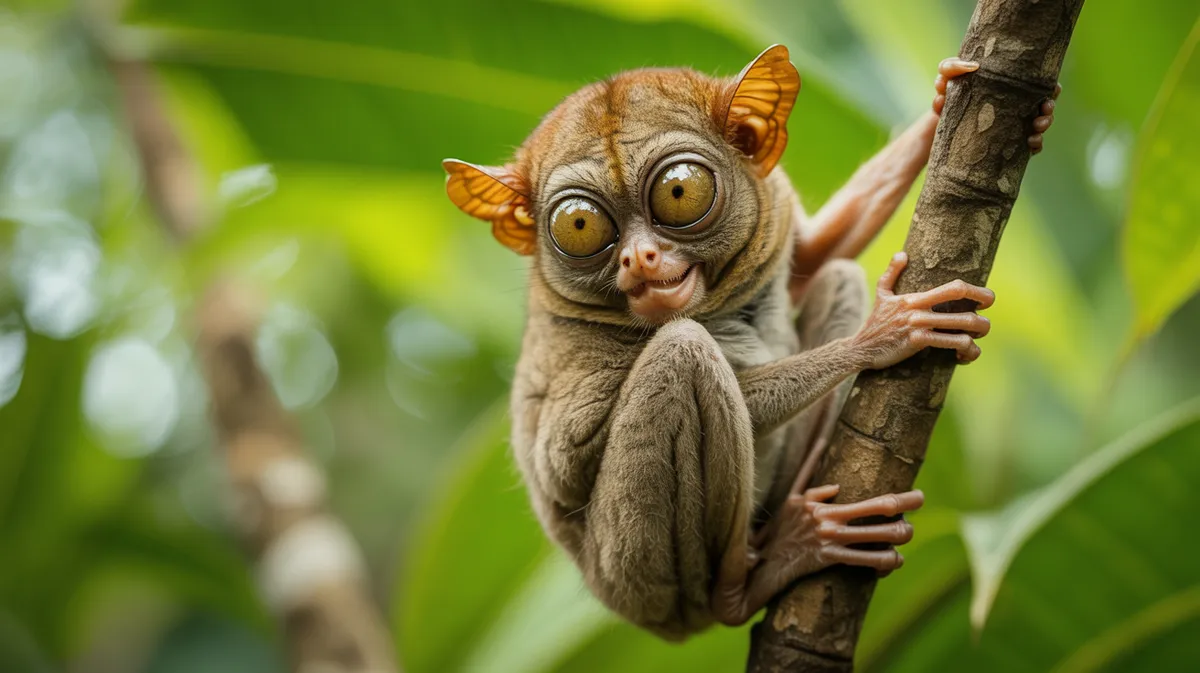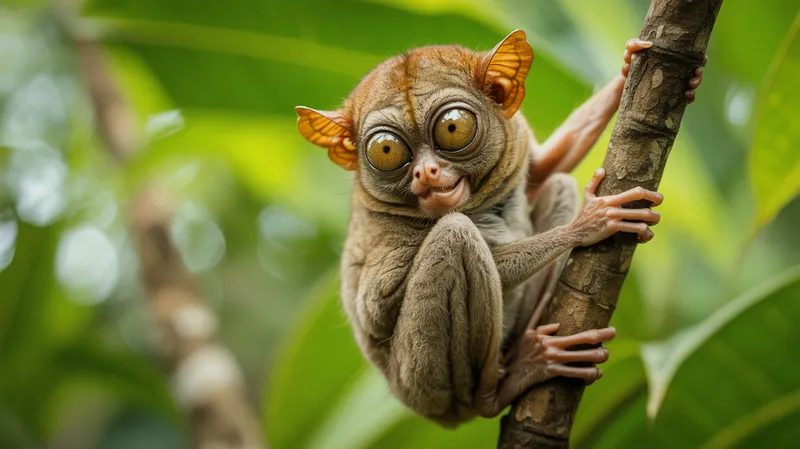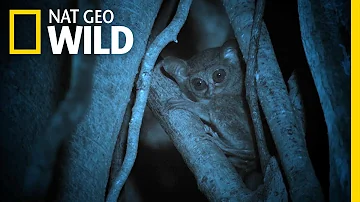
Philippine Tarsier
Carlito syrichta

Meet the Philippine Tarsier
The Philippine tarsier is a small primate known for its enormous eyes and remarkable leaping ability. Native to the forests of the Philippines, this nocturnal animal spends most of its time clinging to tree branches and hunting insects under the cover of darkness. With its unique ability to rotate its head almost 180 degrees, the tarsier can scan its surroundings for both prey and predators. Its long fingers and toes, tipped with adhesive pads, allow it to expertly navigate the dense foliage of its rainforest habitat.
Classification
Mammal
Habitat
Tropical rainforest
Diet
Carnivore
Lifespan
12–20 years
Conservation
Near Threatened
Weight
80–160 grams
📖Fascinating Facts
Giant Eyes
Each of the tarsier's eyes is about 16 mm in diameter, making them the largest in proportion to body size among mammals.
Insect Hunter
Philippine tarsiers feed primarily on insects, but will also eat spiders, small lizards, and birds.
Expert Jumper
Tarsiers use their elongated tarsal bones to leap distances over 2 meters between tree branches.
📋Detailed Description
The Philippine tarsier (Carlito syrichta) is a diminutive primate, typically measuring 9–16 cm (3.5–6.3 in) in body length, with a tail almost twice as long (20–26 cm or 7.9–10.2 in). Its most striking feature is its disproportionately large eyes, each about 16 mm in diameter, which are fixed in their sockets and provide exceptional night vision. The tarsier's head can rotate up to 180 degrees in either direction, compensating for its immobile eyes. Its fur is dense and velvety, ranging from grayish-brown to buff, providing camouflage among tree branches. The hands and feet are elongated, with slender fingers and toes tipped with rounded pads that enhance grip on vertical surfaces. The tarsier's long tarsal bones (ankle bones) enable powerful leaping—individuals can jump more than 3 meters (10 feet) between branches. The species is strictly nocturnal and arboreal, spending daylight hours concealed in dense vegetation or tree hollows. Tarsiers are solitary or live in small, loosely organized social groups, communicating through a repertoire of vocalizations and ultrasonic calls. Their diet consists mainly of insects and small vertebrates, and they are obligate faunivores, rarely consuming plant matter. The Philippine tarsier's reproductive rate is low, with females typically giving birth to a single offspring per year after a gestation period of about six months. The species is highly sensitive to disturbance, and stress can be fatal, making them challenging to keep in captivity.
💡 Did you know?
Unlike most primates, tarsiers are entirely carnivorous, feeding exclusively on insects and small vertebrates.
🔬Research & Sources
Wikipedia Summary
The Philippine tarsier, known locally as mawumag in Cebuano and other Visayan languages, and magô in Waray, is a species of tarsier endemic to the Philippines. It is found in the southeastern part of the archipelago, particularly on the islands of Bohol, Samar and Leyte. It is a member of the approximately 45-million-year-old family Tarsiidae, whose name is derived from its elongated "tarsus" or ankle bone. Formerly a member of the genus Tarsius, it has since been listed as the only member of the genus Carlito, a new genus named after the conservationist Carlito Pizarras.
Last Modified: 5/20/2025
🎭Behavior & Social Structure
Philippine tarsiers are primarily solitary, with individuals maintaining overlapping home ranges of 1–2 hectares. They are most active shortly after dusk and before dawn, using their acute vision and hearing to locate prey. Their hunting strategy involves remaining motionless while scanning for movement, then executing rapid, silent leaps to capture insects, spiders, lizards, and occasionally small birds or bats. Tarsiers use a combination of auditory and olfactory cues to communicate, including high-pitched calls and ultrasonic vocalizations (up to 91 kHz), which are thought to play a role in territory defense and mate attraction. Scent marking with urine and glandular secretions is common. During the day, tarsiers roost alone or in small groups, often returning to the same sleeping site. Social interactions are generally limited to mating and maternal care, though some populations exhibit loose aggregations in areas of high prey abundance.
👶Reproduction & Life Cycle
The breeding season of the Philippine tarsier is not strictly defined but is often correlated with periods of increased food availability. Females are polyestrous and may breed once or twice per year. After a gestation period of approximately 180 days, the female gives birth to a single, well-developed infant. Newborns are precocial, with open eyes and fur, and are able to cling to their mother's belly or be left on branches while the mother forages. Maternal care is intensive during the first few weeks, with weaning occurring at about 80 days. Males do not participate in parental care. Sexual maturity is reached at around two years of age. The species' low reproductive rate contributes to its vulnerability to population declines.
🛡️Adaptations & Survival
The Philippine tarsier exhibits several remarkable adaptations for nocturnal, arboreal life. Its enormous eyes provide a high degree of light sensitivity, facilitating hunting in near-total darkness. The unique structure of its auditory system allows detection of both low-frequency and ultrasonic sounds, aiding in prey localization and communication. The elongated tarsal bones and flexible fingers and toes enable extraordinary leaping and grasping abilities, essential for navigating the complex three-dimensional environment of the rainforest understory. The tarsier's head rotation compensates for its fixed eyes, allowing a wide field of view without moving its body. Its digestive system is specialized for a strictly animal-based diet, with a short, simple gut and a high metabolic rate.
🎨Cultural Significance
The Philippine tarsier holds a unique place in local folklore and cultural identity, particularly in the Visayas region. It is often regarded as a symbol of the Philippines' rich biodiversity and is featured in regional myths as a shy, elusive forest spirit. The tarsier has become an emblematic species for conservation campaigns and ecotourism, especially on the island of Bohol. In some traditions, it is believed that disturbing a tarsier brings misfortune. Historically, there is little evidence of the species being hunted for food or traditional medicine, but it has occasionally been kept as a pet, despite its poor survival in captivity.
🔬Recent Research & Discoveries
Recent research has focused on the tarsier's vocal communication, revealing the use of ultrasonic calls unique among primates. Genetic studies have clarified its taxonomic status, leading to its reclassification into the genus Carlito in 2010. Ongoing ecological studies are examining home range size, habitat preferences, and population genetics to inform conservation strategies. Advances in non-invasive monitoring, such as camera trapping and acoustic surveys, have improved understanding of population densities and distribution. There is also growing interest in the tarsier's visual and auditory adaptations, which provide insights into primate sensory evolution.
🎥Wildlife Videos

THE PHILIPPINES | Secrets of the Archipelago’s Hidden Creatures | Animal documentary
THE PHILIPPINES | Secrets of the Archipelago's Hidden Creatures Welcome to the Philippines – one of the world's most ...
WILD NATURE - Nature animal documentary

Philippines: Islands of Mystery - Wildest Islands - Go Wild
The Philippines are a chain of around 7000 tropical islands in the western Pacific. Unique wildlife has flourished on these ancient ...
Go Wild

The Cutest Little Predator | Wild Indonesia
About National Geographic Wild: National Geographic Wild is a place for all things animals and for animal-lovers alike. Take a ...
Nat Geo Animals

Endangered wildlife: Saving the Tarsier, Philippines' tiny primate
Endangered wildlife: Saving the Tarsier, Philippines' tiny primate Subscribe to France 24 now: http://f24.my/youtubeEN FRANCE ...
FRANCE 24 English

True Facts About The Tarsier
Media Credits : Film Footage courtesy of Shutterstock, Inc., Used by Permission Photos Licensed by: (titles and authors in order of ...
Ze Frank

Tarsiers
Raw footage for a mini-documentary being put together for Bibles in Action New Zealand. The worlds smallest primate. Only found ...
Rob Holding
🌍Habitat Information
The Philippine Tarsier typically inhabits Tropical rainforest environments. Philippine Tarsiers have adapted to their environments with specialized features and behaviors.
Primary Habitat:
Tropical rainforest
More detailed habitat information will be available soon.
🛡️Conservation Status
The Philippine Tarsier is currently classified as Near Threatened. Conservation efforts are crucial for preserving this species for future generations.
Common Threats:
- 🏠Habitat loss and fragmentation
- 🌡️Climate change impacts
- 🎯Hunting and poaching
- 🏭Human-wildlife conflict
⚠️Threats & Conservation Challenges
Major threats to the Philippine tarsier include habitat loss due to deforestation, agricultural expansion, and urban development. Fragmentation of forest habitats isolates populations, reducing genetic diversity and increasing vulnerability to local extinction. Illegal pet trade and capture for tourism also pose significant risks, as tarsiers are highly susceptible to stress and often die in captivity. Predation by domestic animals and invasive species, as well as pesticide use reducing prey availability, further threaten their survival. The IUCN currently lists the species as Near Threatened, with population trends believed to be decreasing. Conservation efforts focus on habitat protection, community-based ecotourism, and public education.
🔬Scientific Classification
Scientific Name
Carlito syrichta
Classification Hierarchy
🔍 About Taxonomic Classification
Taxonomic classification is a hierarchical system used by scientists to classify and organize living organisms based on shared characteristics and evolutionary relationships.
The system moves from broad categories (Kingdom) to increasingly specific ones, with each animal's scientific name typically consisting of its Genus and species.
📝Community Notes
Share your observations and insights about the Philippine Tarsier with our community of wildlife enthusiasts.
Join Our Community
Sign in to share your observations and connect with fellow wildlife enthusiasts.
Sign In to ContributeNo community notes yet
Be the first to share your observations about the Philippine Tarsier!
Explore Philippine Tarsier
Select a tab above to learn more about this amazing animal.
📸Photo Gallery
No photos available for this animal yet.
🌟Discover More Wildlife
Continue your journey of discovery with more fascinating animals from our database
